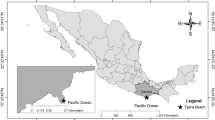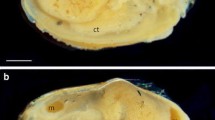Abstract
The lobate ctenophores Ocyropsis maculata and O. crystallina are not simultaneous hermaphrodites, based on morphological, histological and experimental evidence. Sex ratios in populations, sex ratios of size classes within populations, and average sizes of males and females support the hypothesis that both species are dioecious, rather than sequential hermaphrodites. We have divided each species into two subspecies, based on morphology and geographic distribution. Preliminary evidence suggests that the subspecies also differ in reproductive behavior. One subspecies, O. crystallina guttata, spawns on a daily cycle in the laboratory, and spawning becomes more synchronous when males and females are placed together. Species of Ocyropsis, all of which are oceanic in distribution, are probably descended from a common ancestor that was a simultaneous hermaphrodite. That this group of oceanic ctenophores evolved dioecy directly contradicts the assertion that there is a selective advantage to hermaphroditism in environments where the probability of finding a mate is reduced.
Similar content being viewed by others
Literature cited
Backus, R. H. and J. E. Craddock: Pelagic faunal provinces and sound-scattering levels in the Atlantic Ocean. In: Oceanic sound scattering prediction, pp 529–547. Ed. by N. Andersen and B. Zahuranec. New York: Plenum Press 1977
Barnes, R. D.: Invertebrate zoology. Philadelphia: W. B. Saunders Coll. 1980
Bigelow, H. B.: Medusae from the Maldive Islands. Bull. Mus. comp. Zool. Harvard 39 (9), 245–269, pl. 8 (1904)
Childress, J. J.: Oceanic biology: lost in space? In: Oceanography the present and the future, pp 127–135. Ed. by P. G. Brewer. Heidelberg, New York: Springer-Verlag 1983
Chiu, S.-Y.: On the metamorphosis of the ctenophore Ocyropsis crystallina (Rang) from Amoy. Acta zool. sinica 15 (1), 10–16 (1963)
Chun, C.: Ctenophoren des Golfes von Neapel. Fauna Flora Golf Neapel 1, 313 pp., 16 pls. (1880)
Dawydoff, C.: Les coeloplanides indochinoises. Arch. Zool. gén. 80, 125–162 (1938)
Dawydoff, C.: Contribution a la connaissance des ctenophores pelagiques des eaux de l'Indochine. Bull. Biol. Fr. Belg. 90, 113–170 (1946)
Dawydoff, C.: Observations sur la metamorphose d'Ocyropsis, ctenophore archilobe de la faune indochinoise. Compt. Rend. Acad. Sci., Paris. 226, 1105–1106 (1948)
Eschscholtz, F.: System der Acalephen. Berlin: F. Dümmler 1829
Fewkes, J. W.: XI. Report on the Acalephae. Bull. Mus. comp. Zool., Harvard 8 (7), 127–140, 4 pls. (1881)
Freeman, G. R. and G. Reynolds: The development of bioluminescence in the ctenophore Mnemiopsis leidyi. Dev. Biol. 31, 61–100 (1974)
Gegenbaur, C.: Studien über Organisation und Systematik der Ctenophoren. Arch. Naturgesch. 22, 163–205, pls. 7–8 (1856)
Ghiselin, M. T.: The economy of nature and the evolution of sex, pp 118–125. Berkeley: University of California Press 1974
Gilbert, J. J. and T. L. Simpson: Sex reversal in a freshwater sponge. J. exp. Zool. 195, 145–151 (1976)
Hamner, W. M., L. P. Madin, A. L. Alldredge, R. W. Gilmer and P. P. Hamner: Underwater observations of gelatinous zooplankton: sampling problems, feeding biology and behavior. Limnol. Oceanogr. 20, 907–917 (1975)
Harbison, G. R.: 6. On the classification and evolution of the Ctenophora. In: The origins and relationships of lower invertebrates, pp 78–100. Ed. by S. C. Morris, J. D. George, R. Gibson and H. M. Platt. Oxford: Oxford University Press 1984
Harbison, G. R. and L. P. Madin: Diving — a new view of plankton biology. Oceanus 22, 21–27 (1979)
Harbison, G. R. and L. P. Madin: The Ctenophora. In: Synopsis and classification of living organisms, pp 707–715, pls. 68–69. Ed. by S. P. Parker, New York: McGraw-Hill 1982
Harbison, G. R., L. P. Madin and N. R. Swanberg: On the natural history and distribution of oceanic ctenophores. Deep-Sea Res. 25, 233–256 (1978)
Hardy, A.: The open sea; its natural history, 2 vols, 2nd ed. London: Collins 1970
Heath, D. J.: Simultaneous hermaphrotidism: cost and benefit. Theor. Biol. 64, 363–373 (1977)
Hyman, L. H.: The invertebrates: protozoa through ctenophora. New York: McGraw-Hill 1940
Komai, T.: On ctenophores of the neighbourhood of Misaki. Annot. Zool. Japan 9, 451–474. pl. 7 (1918)
Komai, T.: Notes on Coeloplana bocki n. sp. and its development. Annot. Zool. Japan 9, 575–584 (1920)
Komai, T.: Studies on two aberrant Ctenophores, Coeloplana and Gastrodes, Kyoto: Published by the author 1922
Komai, T.: A note on the phylogeny of the Ctenophora. In: The lower metazoa: comparative biology and phylogeny, pp 181–188. Ed. by E. C. Dougherty. Berkeley: Univ. of Calif. Press 1963
Kremer, P. and S. W. Nixon: Distribution and abundance of the ctenophore, Mnemiopsis leidyi in Narragansett Bay. Estuar. cstl mar. Sci. 4, 627–639 (1976)
Krempf, A.: Sur un cténophore planariforme nouveau Coeloplana gonoctena (nov. sp.). Compt. Rend. Acad. Sci. Paris 171, 438–440 (1920)
Krempf, A.: Coeloplana gonoctena: biologie, organisation, développement. Bull. Biol. Fr. Belg. 54, 252–312 (1921)
Krumbach, T.: Zweiter Unterstamm der Coelenterata Acnidaria — Collaria — Greifzellentiere. In: Handbuch der Zoologie, vol. 1, pp 902–995. Ed. by W. Kükenthal and T. Krumbach. Berlin and Leipzig: De Gruyter & Co. 1926
Madin, L. P. and G. R. Harbison: Bathocyroe fosteri gen. nov., sp. nov.: a mesopelagic ctenophore observed and collected from a submersible. J. mar. biol. Ass. U.K. 58, 559–564 (1978)
Marshall, N. B.: 7. Animal ecology. In: Deep oceans, pp 205–224. Ed. by P. J. Herring and M. R. Clarke. New York: Praeger 1971
Mayer, A. G.: Ctenophores of the Atlantic coast of North America. Washington: D. C.: Carnegie Inst. 1912
Mertens, H.: Beobachtungen und Untersuchungen über die beroeartigen Akalephen. Mèm. Acad. imp. Sci. St.-Petersbourg. (6th ser.) 2, 479–543, pls. 1–13 (1833)
Miller, R. L.: Sperm chemotaxis in the hydromedusae. I. Species-specificity and sperm behavior. Mar. Biol. 53, 99–114 (1979)
Miller, R. L.: Identification of sibling species within the “Sarsia tubulosa complex” at Friday Harbor, Washington (Hydrozoa: Anthomedusae). J. exp. mar. Biol. Ecol. 62, 153–172 (1982)
Miller, R. L. and K. King: Sperm chemotaxis in Oikopleura dioica (Urochordata: Larvaceae). Biol. Bull. mar. biol. Lab., Woods Hole 183, 419–428 (1983)
Moser, F.: Japanische Ctenophoren. Beiträge zur Naturgeschichte Ostasiens. Herausgegeben von Dr. F. Döflein. Abhandl. math.-phys. Klasse K. Bayer. Akad. Wiss., Vol. 4, Suppl. 1, 77 pp 1908
Pianka, H. D.: 4. Ctenophora. In: Reproduction of marine invertebrates, vol. 1, pp 201–265. Ed. by A. C. Giese and J. S. Pearse. New York and London: Academic Press 1974
Rang, P. C. A. L.: Etablissement de la famille des Beroides dans l'ordre des Acalèphes libres, et description de deux genres nouveaus qui lui appartiennent. Mèm. Soc. Hist. nat., Paris 4, 166–173 (1828)
Reeve, M. R. and M. A. Walter: Nutritional ecology of ctenophores — a review of recent research. In: Advances in marine biology, vol. 15, pp 178–199 New York: Academic Press 1978
Reynaud: La callianire bucephale. In: Centurie zoologique ou Choix d'Animaux rares, nouveaux ou imparfaitement connus, pp 84–85, pl. 28. Ed. by R. P. Lesson. Paris: F. G. Levrault 1830
Author information
Authors and Affiliations
Additional information
Communicated by J. M. Shick, Orono
Rights and permissions
About this article
Cite this article
Harbison, G.R., Miller, R.L. Not all ctenophores are hermaphrodites. Studies on the systematics, distribution, sexuality and development of two species of Ocyropsis . Mar. Biol. 90, 413–424 (1986). https://doi.org/10.1007/BF00428565
Accepted:
Issue Date:
DOI: https://doi.org/10.1007/BF00428565




